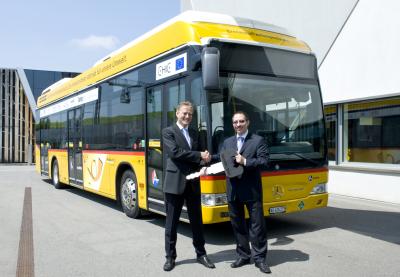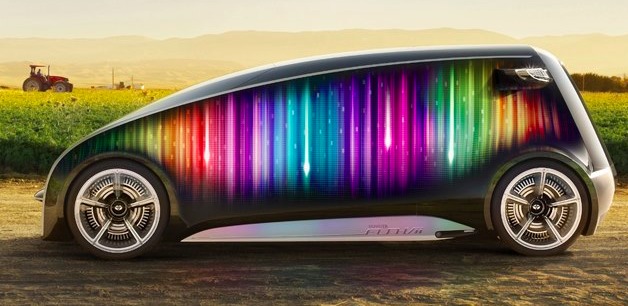
PostAuto Schweiz AG has become the first company in Switzerland to deploy fuel-cell technology for public road transport.
Since the end of 2011, five Mercedes-Benz Citaro FuelCELL Hybrid models have been serving on routes in and around Brugg (in the canton of Aargau) as PostAuto vehicles. Over the next five years, PostAuto will test the fuel-cell drive, using clean hydrogen as fuel.
The dense network of routes operated by PostAuto around Brugg is ideally suited to the test in terms of both topography and routing, with a mixture of city traffic, country roads and village streets. The routes will be operated by the PostAuto company Voegtlin-Meyer AG, which will also service and refuel the five fuel-cell post vehicles at its garage location.
Aargau Canton is supporting the fuel-cell bus project with a subsidy of 1.5 million Swiss francs from the Swisslos lottery fund. PostAuto expects to save some 2 000 tonnes of CO2 during the five-year test phase.
Hartmut Schick, head of Daimler Buses, is delighted about the promising deployment of the eco-friendly fuel-cell buses: “I recently had the opportunity to see them in actual operation, and I was very impressed with the way PostAuto Schweiz has implemented the concept.”
Citaro FuelCELL-Hybrid
Compared with the fuel-cell omnibuses that were tested from 2003 on as part of the CUTE and HyFLEET:CUTE projects, the new Citaro FuelCELL Hybrid offers significant innovations: hybridisation with energy recovery and storage in lithium-ion batteries, powerful electric motors fitted in the wheel hubs with a continuous output of 120 kW, electrified PTO units and more advanced fuel cells.
These cells will have an extended service life of at least five years, or 12 000 operating hours. The fuel-cell stacks in the new Citaro FuelCELL Hybrid are identical to those used in the Mercedes-Benz B-Class FCELL with fuel-cell drive. As in the earlier fuel-cell buses, the two stacks are already installed on the vehicle’s roof.
A new addition is lithium-ion batteries, which store energy that is recovered during braking. With the electric power from this energy accumulator, the new Citaro FuelCELL Hybrid is able to run for a number of kilometres on battery power alone. The concept behind the new FuelCELL bus essentially corresponds to that of the Mercedes-Benz BlueTec hybrid buses. However, these derive their electric power from a diesel generator, whereas in the new FuelCELL buses the fuel cells generate the electricity for the drive motors, without producing any emissions whatsoever.
The improved fuel-cell components and the hybridisation with lithium-ion batteries result in a reduction in hydrogen consumption of almost 50 percent for the new Citaro FuelCELL Hybrid compared with the previous generation. As a result, it has been possible to reduce the number of tanks from the total of nine on board the fuel-cell buses deployed in earlier trials to seven on the current vehicles, holding 35 kg of hydrogen in all. The operating range of the fuel-cell bus is over 250 kilometres. With these diverse technical advances, buses running on electric power alone with fuel cells as energy generators are now a major step closer to production maturity.
CHIC (Clean Hydrogen in European Cities) project
This EU-funded project will permit the integration of 26 fuel-cell buses into daily regular services in five European cities.
The project is based on a gradual introduction of hydrogen-powered fuel-cell buses, and aims to set up bus fleets with fuel-cell vehicles, along with the necessary infrastructure. With the CHIC project, Daimler Buses is following up on two previous successful projects, CUTE and HyFLEET:CUTE, launched by the European Union, which ran from 2003 to 2009.
A total of 36 Mercedes-Benz Citaro with second-generation fuel-cell drives have already proven their worth at twelve transport operators on three continents. With more than 140 000 operating hours and a total distance travelled of over 2.2 million kilometres, Mercedes-Benz buses have demonstrated the practical application of the eco-friendly fuel-cell drive.



